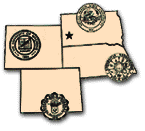Animal Science, Department of

Range Beef Cow Symposium
Date of this Version
12-9-1997
Document Type
Article
Abstract
Given the relatively high fiber and moderate crude protein concentrations in Ponderosa pine needles (Adams et al., 1992; Pfister et al., 1992) and their potential negative effect on organic matter digestibility and nitrogen retention in ruminants (Adams et al., 1992), it is not readily apparent why cattle eat them. However, there are a number of ideas that may help explain why they do. Ponderosa pine needles contain a variety of nutrients and precursors including glucose, fructose, galactose, sucrose, citric acid, shikimic acid (a precursor in the biosynthesis of the amino acids phenylalanine, tyrosine and tryptophan), crude protein (Pfister et al., 1992; Adams et al., 1992), a variety of minerals (Kronberg, unpublished data), and probably some vitamins. The needles also contain large amounts of phytochemicals including monomeric phenolics, flavonoids, terpenes, and tannins (Pfister et al., 1992; Adams et al., 1992).
Five potential reasons for ingestion of Ponderosa pine needles by cattle include: 1) inadequate availability of alternative vegetation or supplements that could satisfy their hunger, 2) to obtain needed nutrients that are not available from alternative feeds, 3) to reduce negative physiological consequences resulting from their ingestion of other feeds (self medication) , 4) they find the flavor of needles desirable for reasons unrelated to those listed above so they eat them, and 5) they are bored with other vegetation or feeds that are available to them and therefore eat the needles because they are novel.
Numerous observations by ranchers and scientists support the idea that cattle will eat Ponderosa pine needles even when other forages and (or) concentrates are available. Whether or not these alternative feeds usually meet their nutrient requirements is unknown because the nutrient content of ranch feeds is often not known, and even in research situations, our understanding of cattle nutrition and feed quality is imperfect. If hungry cattle are eating the needles because there is little available alternative feed in their pastures because it has been grazed out, covered by snow, or is not being supplemented to them, then the solution is obvious.


Comments
Published for Proceedings, The Range Beef Cow Symposium XV December 9, 10 and 11, 1997, Rapid City, South Dakota.